 |
||
|
||
| ||
Part I: Hard discs and controllersOur lab not so long ago managed to fetch a new disc model Western Digital with a record density equal to 30 GBytes per platter. As soon as I test it, I will give you the results. But already now I can speculate that it will take the lead among 5400 rpm discs, and in some parameters (e.g. in the linear reading speed) it will nearly catch up with 7200 rpm devices. Many ask why we don't include Maxtor discs in the rating. The problem stems from the difficulty to get the products from this company. I hope the situation will change soon for the better. At the same time, Maxtor discs are rather good (Diamond Max VL40 and VL15 series - 5400 rpm, Diamond Max Plus 60 - 7200 rpm). The rating of hard discs hasn't undergone any changes. Discs from 10 to 20 GBytes 5400 rpmHere we have entry-level discs. Although performance is very high, you save a lot of money. The prices within this class differ slightly. The Seagate U5 is a leader. The Fujitsu MPF 3xxxAT is a leader in the economic class. I would recommend you to go with the Fujitsu. Discs from 10 to 20 GBytes 7200 rpmThese discs are for those who don't need to store huge volumes of data. In my opinion, a price-to-performance ratio (effectiveness) is a determining factor. It is difficult to mark out a leader, that is why I give you only my humble opinion. The leader is the Quantum Fireball Plus AS. In the economic class the leader is the Seagate Barracuda ATA II. Discs from 20 GBytes 5400 rpmThese discs are designed only data storage. It makes no sense to talk about high efficiency. The Seagate U5 is a leader. In the economic class the leader is the Western Digital WD450AA. Discs from 20 GBytes 7200 rpmA high linear read speed (it should be as even as possible along the whole disc), a low access time. To cut a long story short, the performance matters most of all. The leader is the IBM 60GXP. Perhaps, IBM was the last to release a disc with 20 GBytes record density per platter. The disc turned out to be quick. As for its reliability - it is difficult to say. In the economic class the leader is the IBM DTLA. On the whole, the discs' characteristics are now much closer to each other. It means that you can buy a disc from any manufacturer - it will provide the required operating speed. Optical recording devices (CD-RW) |
|
Tweet | ||
The summer has started already, it means that time of traditional slackness on the market of high technologies will come very soon. But despite it, top CD-RW drive manufacturers are keeping on announcing new developments.
Earlier I've already mentioned that the recorders with 4/4/32 speeds are gradually disappearing from the market. And those models that are still lying in the stores sell at the reduced price less than $100. At the end of May Mitsumi 4804 and LG CED8083 drives could be easily found at $80-90. Such a solid reduction of the price may soon lead to ousting FDDs from computers of many users. And maybe floppy disc drives will be followed by CD-ROM drives.
The CD-R media market is still in the sluggish crises. The majority of top manufacturers note that there is a noticeable deficit. This situation is connected not only with the fact that a great deal of companies has lost in the struggle in the market where income is possible in case of only large sales volumes, but also with the fact that there are certain unsolved problems among disc manufacturers and owners of patents for their production.
The final ratification of the Orange Book Part II Volume 2 standard by the Philips/Sony consortium where all requirements for Multi-Speed (16X and higher) CD-R media are stipulated was a considerable event of the last month. Apart from the Orange Book Part II, the parameters and characteristics of the High-Speed CD-RW discs (reflected in the Orange Book Part III) were considered and approved. The DDCD-R format was also paid due attention to. There is still no final specifications, but according to the consortium participants, they will appear in the near future, and among colorful books we now have got one more - Purple Book. For more detailed information go to the Philips site, and download pdf-files CD-R and CD-RW Disc Drive Verification (129 KBytes) and MID - Manufacturer IDentification Code (41 KBytes).
Below is our TOP of the recommended CD-RW drives.
This category means high quality and reliability, and, of course, a high price of a recorder.
The Ricoh MP7200A was included in here with some uncertainty. First of all, it is still a new model, and therefore, it is quite difficult to find now. Secondly, we tested only a pre-production sample. I can't state the production one will be "spoilt", but some companies are known for such examples.
The MP7200A shows quality recording at high speeds, fast reading of discs, perfect operation with CD-RW media and some reserve, until a release of Multi-Speed CD-Rs. The drive will cost a maximum of $270-280, which is not too much for the latest development from Ricoh.
These two devices are based on the Sanyo pickup and show very close results in the tests. Nevertheless, a price gap is becoming wider with time in favor of the CyClone. A user who wants a "nearly Plextor" but for less money, should take exactly the TDK recorder. Nevertheless, who wants the highest quality recording and reliability should take the PlexWriter.
The PX-W1610A gives true 16X recording and a new technology - "Powerec" (Plextor Optimized Writing Error Reduction Control), apart from Burn-Proof. This technology detects a type of a CD-R disc used and choose an appropriate record speed for it.
Besides, the PlexWriter has an excellent speed and high quality of sound track extraction. On a well-balanced disc the speed can be as high as 30x! And at such a high read speed the recorder works very quiet.
That is why if you have decided to purchase a CD-RW drive with high quality recording, stable reading, a pleasant design and which is capable to replace your favorite Mitsumi, which in the most cases works under the CloneCD program, then go with this high-speed recorder from TDK.
This category includes relatively high speed devices at an average price and with an optimal ratio of speeds (today it is 12/10/32).
The price of this recorder has dropped much during the last months, and the CD-W512EB is one of the cheapest devices based on the Sanyo's pickup. This device has shown very high results in our tests, similar to the competitor from Plextor. The BLER factor is just a bit higher than that of the PX-W1210TA, the speed results are very high, like those one of the TEAC. The access speed is even higher than that of the brand-name opponent. Its quite low price together will all advantages listed above make this recorder a good competitor on the recorder market.
This category implies a low price and clear realization of what you are purchasing.
This model is one of the bestsellers in its sector. Its popularity is accounted by the well thought-out TEAC's marketing campaign - a moderate price ($120-130), reliability and high quality of the products, both ╬EM and Retail packages.
So, if you really need an 8x speed at the moderate price, then take the CD-W58E.
This recorder is primarily interesting for those who like to make backup copies of discs. The CR-4805TE supports all possible read/write RAW formats: RAW-DAO, RAW-DAO Write Simulation, CD+G RAW-DAO, RAW-SAO, RAW-SAO Write Simulation.
Its record quality is excellent for its class. A high and correct read speed and 8x record speed, plus a low price ($115-120) makes this recorder a good purchase for a not very demanding user in respect of CD recording.
The month was started with summation of the results of the first fiscal year by top manufacturers of CD-R media in Taiwan. According to such top manufacturers as Ritek, CMC Magnetics, Lead Data, InfoDisc the income has much fallen down as compared with this period of the last year, and profitability is close to 0 or even negative.
Against the background of fast spreading information on considerable increase of prices for CD-R discs, the announcement of the Plextor 24/10/40 CD-RW drive with a 2-year warranty and a price just a bit higher than that of the PX-W1610A seems to be unnoticed. It will support both ATAPI and SCSI and probably even FireWire interfaces. The PXW2410A will be reportedly released in June.
As we said before, Philips called back licenses (temporally) for production of CD-R media from many Taiwanese manufacturers. The matter is that they refused to pay high royalties (up to $0.045 for each CD-R disc) to Philips. The licenses were called back from many companies except Acer Computer Technology and Nan Ya Plastics Corp. Today CMC Magnetic and Philips are still holding talks on reestablishment of the license agreement. Apart from the claims of Philips, the corresponding committees of the European Union have decided to expand an antidumping investigation against Taiwanese CD-R manufacturers with two more companies (so far they were three - Ritek, CMC Magnetic and Princo). But what companies is unknown.
Again the announcement of the Acer CMA (Acer Communications & Multimedia America Inc.), the division of Acer America, on the starting of delivering of a portable CD-RW 6424MU drive at the retail price of $219 might have become unnoticed.
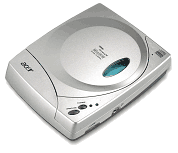
The major specs are: 6/4/24 speeds, 2 MBytes buffer, USB 1.1 interface (PCMCIA and Firewire/IEEE 1394 optionally), 180 ms access time. In addition to it - the previous model - the first external 6x CD-RW 6406EU drive with a USB interface is selling now at $179. The company is planning on the release of the 1212EF by the end of September, an external combined CD-RW/DVD drive. All three models are equipped with the buffer underrun error prevention technology Seamless Link.
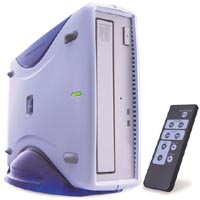
The Japanese company Adtec at the end of May is going to start shipping an external CD-RW device capable to play MP3 files using an internal hardware decoder. The AD-RW1210/MP3 drive has 8/8/8 speeds and connects to a computer via the USB 1.1 interface. It gives the ground for some questions connected with the difficulty to realize constant stable data transfer in both directions. That is why the device features the BURN-Proof technology and has 4 MBytes buffer memory. The AD-RW1210/MP3 weighs 1.8 kg and will cost approximately $244.
The AD-RW1210/MP3 is surprisingly similar to the CD-RW drive from TEAC ;-) The coming price growth for CD-R media will be compensated by the price drop for the drives, which is connected with the rapid development of this market. Here are figures obtained from some Taiwanese CD-RW drive manufacturers:
| Manufacturer | Q1 2001 | Forecast for 2001 | Shipping in 2000 | Growth rate |
| Aopen | 70,000 | 750,000 ~ 1.0 million | 300,000 | 250 % |
| Behavior Tech (BTC) | 100,000 | 1.0 million | less than 100,000 | 1,000 % |
| Lite-On | 600,000 | 4.9 million | 2.4 million | 100 % |
The rapid development of home studios for CD-R recording has given an additional stimulus for production of simple and relatively cheap printers for printing on an idle surface of discs. Primera has announced a first on the market for printing on CDs; it was yet displayed at CeBIT 2001. This new color CD printer.
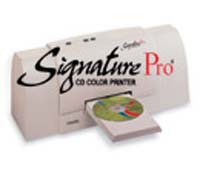
SignaturePro CD, as compared with previous models Signature IV and Signature Pro, has twice better print resolution, double speed and double cartridge capacity. The major characteristics are: bubblejet technology, resolution up to 2400 x 1200 dpi (2.88 million of pixels per square inch), 100% covering of the surface at 16 sec, monochrome - at 2 sec (at 15% covering), operation with 120 mm CD-R and DVD-R media; 58 x 86 mm CD business cards support (with an additional adapter). Interfaces are parallel and USB. The device measures 190 x 32 x 266 mm and weighs 4.3 kg. The retail price of the SignaturePro CD will be $1895.
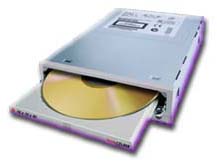
In the middle of the month Iomega started selling its new internal CD-RW drive 16X10X40 and an ATAPI interface. The drive is equipped with the traditional BURN-Proof technology and 32X sound track extraction speed from audio CDs. The retail price of the Iomega 16X10X40 specified in the press release is $199.
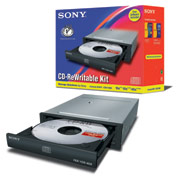
On May 16 Sony published on its site specs of a new 16x CD-RW drive CRX168B.The drive features 16/10/40 speed and has an ATAPI (EIDE) interface with UDMA33 support. An average access time is 125 ms, a buffer size is 8 MBytes. Obviously, there is no any buffer underrun error prevention technology. In the press release they say that the device prevents rewriting of 130 MB MPEG-files converted from the MPEG-VCD format. When detecting such file the recording just stops. No information on the price or the beginning of shipping is not given.
In the middle of the month Yamaha introduced a family of LightSpeed CRW2200 drives. The general speed formula is 20/10/40. The CRW2200 drive allows for grabbing a standard 74-minute Audio CD less than at 3 minutes. The zest of the series is a first time applied in the CRW2200 record technology Partial Constant Angular Velocity (P-CAV), the main idea of which is combination of the CAV technology and the standard CLV. The CAV maintains the disc rotation speed constant, and a recording speed depends on what part of a disc is being recorded. In the Yamaha CRW2200 a new proprietary technology will be also used - the Yamaha SafeBurn System - an extended control system of a recording buffer which is 8 MBytes in this family. The Yamaha LightSpeed series consists of 5 models:

By the end of the month some companies announced Multi-Speed CD-R discs. Mitsui Advanced Media and Ricoh launched CD-R discs for 24-x recording. Mitsui seems to be the first to guarantee that its SG Ultra II discs will be burnt at such a high speed. Ricoh said that it will equip its new 20-x MP7200A drive with exactly these discs. TDK announced that they will start delivering 24X CD-R media in June.
MSI is ready to launch its new multimedia device - CD-RW StarSpeed MS-8312 drive with ATAPI interface.
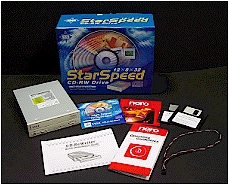
It is interesting that at the Comtec MSI representatives said that the company was not going to start production of recorders. The drive sports 12/8/32 speeds, 85 ms access time, Seamless Link technology, analog and digital line-outs (SPDIF). There is no information on a buffer size and the price of the StarSpeed MS-8312. But, in my opinion, this model is very similar to the Acer's one, and I can assume that the MSI device will have some 2 MBytes buffer.
At the end of the month Predator announced a new CD-RW drive with USB 2.0 interface support. The CRWU2-B1610 recorder features 16/10/40, the buffer underrun error prevention technology, and supports both USB 1.1 and 2.0.
|
Tweet | ||
Storage devices based on the Flash memory are gradually transferring from the exotic sphere to everyday things. It is mainly caused by the rapid development of such devices as Mp3 players, digital cameras and PDA. A next splash of the technologies of data storage devices based on Flash may be expected to take place at Computex in Taiwan. That is why I want to examine major trends of this market.
Now it is widely discussed that Flash cards can replace FDDs. A compact size of Flash cards, perfect data protection from damages and copying (if necessary), price decreasing for data storage give a good change for these cards. Flash-card readers have become equal in prices with FDDs. But I think that is it too early to state that Flash cards have already replaced FDDs. I would rather say that Flash cards have established a new class of devices with removable storage medium. The market of Flash cards is in a state of chaos now. Instead of making efforts for joining up, the manufacturers are trying to outsmart one another.

SONY, for example, has released a Flash card of its won standard - Memory Stick. The Card is produced in two types: with an integrated copyright protection system (Magic Gate) and a usual one.
Today all types of Flash cards can be divided into two main types:


Now when we have taken a proper look at the media, let's take a gander at the drives for them. Virtually any digital photo camera or MP3 player can implement a role of a drive, but it isn't always convenient. That is why there is a great variety of devices for reading and recording Flash cards. Such devices can support several standard for Flash cards. The Taiwanese manufacturers have introduced not so long ago a universal monster that can read nearly all existent types of Flash cards (CompactFlash, SmartMedia, MultiMediaCard, MemoryStick, Secure Digital Card).


But as a rule, the devices are intended for one or two types of
Flash cards. Such devices are cheaper and smaller. Now the USB is a prevailing interface for such devices, since it is the most popular on PCs and provide a good data transfer speed and hot connection. But devices with FireWire and Parallel(LPT) interfaces are also widely available. Besides, the market offers one more intriguing device - a floppy disk adapter for Flash cards :). The major disadvantage of all such drives is a necessity to install drivers when connecting a device for the first time.
At the beginning of this year several companies introduced a new technology of Flash storage media. Here we can see an original idea of combining a drive with a USB interface and Flash memory.
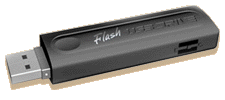
According to the developers, the Flash USBDRIVE is based on an electrically programmable ROM (or Flash) which communicates with a computer via a USB-port. Combination of these two technologies allowed the developers to create a pocket-size medium for storing large volumes of data, with data exchange with a computer being fast ad simple. The USB-interface allows for connecting devices without a need to switch off and reboot the system. The device is detected right after it's attached to a free USB input. The Flash USBDRIVE is displayed as a usual hard disc. The Flash USBDRIVE is powered from a USB-port that is why it doesn't require an additional power source or cables.
The price of this device is still too high. And today it is cheaper to buy a Flash card with a reading device working via a USB interface.
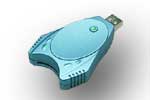
Besides, you will get a removable storage medium. And you have to install drivers for this device. By the way, the competitors have offered such Flash card reader:
The price of such device is usually lower due to lack of an interface cable.
All above mentioned devices require driver installation. But at the beginning of this year the market received Flash discs which are introduced as a standard hard disc and connect via an IDE interface. Such devices are, for example, produced by PQI .

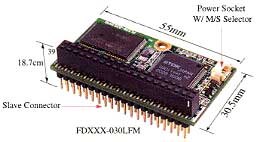
So, you are to attach this module to the IDE connector on the board or connect it to the IDE cable, and you get a normal hard disc. It can be set as Master or as Slave. Some models have an additional IDE connector for one more disc. BIOS detects it automatically. In case of problems you can set the necessary parameters manually. After that you can partition it with the Fdisk utility and then format. This device can be a loading device. The disc is powered via an IDE interface or from an external power supply unit. Such variant can be very useful for industrial computers where a high reliability of data is required. It also suits perfectly for special-purpose tasks where minimal power consumption and a minimal computer size are required.

This one is a cumbersome competitor - 2.5" IDE HDD. You get all advantages and disadvantages of the Flash technology in a standard case. The worst drawback is a low data transfer rate. Among the highs there are: high reliability of data storage, absence of mechanical parts and low power consumption. I think that such devices will become popular when Web-Pads and advanced PDAs will be widely adopted. For example, in case of the Web-Pad a hard disc will be necessary for additional functions. But I think that the device should have smaller dimensions.
The review is based on the materials from the following sites:
and from the sites of the following manufacturers:
Write a comment below. No registration needed!
|
Article navigation: |
| blog comments powered by Disqus |
| Most Popular Reviews | More RSS |
 |
Comparing old, cheap solutions from AMD with new, budget offerings from Intel.
February 1, 2013 · Processor Roundups |
 |
Inno3D GeForce GTX 670 iChill, Inno3D GeForce GTX 660 Ti Graphics Cards A couple of mid-range adapters with original cooling systems.
January 30, 2013 · Video cards: NVIDIA GPUs |
 |
Creative Sound Blaster X-Fi Surround 5.1 An external X-Fi solution in tests.
September 9, 2008 · Sound Cards |
 |
The first worthwhile Piledriver CPU.
September 11, 2012 · Processors: AMD |
 |
Consumed Power, Energy Consumption: Ivy Bridge vs. Sandy Bridge Trying out the new method.
September 18, 2012 · Processors: Intel |
| Latest Reviews | More RSS |
 |
Retested all graphics cards with the new drivers.
Oct 18, 2013 · 3Digests
|
 |
Added new benchmarks: BioShock Infinite and Metro: Last Light.
Sep 06, 2013 · 3Digests
|
 |
Added the test results of NVIDIA GeForce GTX 760 and AMD Radeon HD 7730.
Aug 05, 2013 · 3Digests
|
 |
Gainward GeForce GTX 650 Ti BOOST 2GB Golden Sample Graphics Card An excellent hybrid of GeForce GTX 650 Ti and GeForce GTX 660.
Jun 24, 2013 · Video cards: NVIDIA GPUs
|
 |
Added the test results of NVIDIA GeForce GTX 770/780.
Jun 03, 2013 · 3Digests
|
| Latest News | More RSS |
Platform · Video · Multimedia · Mobile · Other || About us & Privacy policy · Twitter · Facebook
Copyright © Byrds Research & Publishing, Ltd., 1997–2011. All rights reserved.